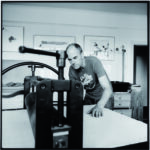Transformations
If I had to summarise my artistic work in a few terms, I would call them:
Transformation - Process - Time
The earth is in a permanent process of transformation by us humans and without us.
This transformation is expressed in the light etchings of the ‘In the Woods’ cycle. Over time, an entire forest grows over the remains of cars until only fragments of the wrecks can be recognised in the thicket (work #920). It is fascinating how trees have grown out of and over the cars, as if nothing could block their path to the light. Forests on the light-flooded shores of the Baltic Sea are also the subject of the ‘Coastal Forest’ series; these works are also about transformation processes at fault lines, when the sea transforms the shore in endless constancy. The starting motif for the light etchings is always a carefully taken and selected photograph, which I then transform into a print via the printing process.
Trees form the basis of my sculptures. They are found objects on the banks of the Elbe near Hamburg. If I discover an interesting fragment in the mud at low tide, it is painstakingly and carefully retrieved. After a long drying phase, I start working and refining it and making a steel base. In the beginning, they are mostly dark, wet fragments that are barely distinguishable from the slag stones on the shore and only hint at the interesting shapes and precious wood hidden inside.
They are often fragments of piles, dolphins, bollards or groynes that have been moulded by the tidal current over years, decades or even centuries and are sometimes - rather rarely - washed up near the shore. The artefacts are heavily soaked and sometimes icy in winter.
The oak and softwood trunks, which have been rammed into the sediments of the Elbe for centuries for shipping, are very well preserved due to the lack of oxygen in the brackish water and can last for several hundred years as long as they are not exposed to air. At their core, the quality of the wood is outstanding and it is important to uncover and refine it. In addition to the sculpture in space, feeling the forms forms the 4th dimension. The perception of the art object should not be limited to viewing it from different perspectives, but also feeling the finely polished surfaces and shapes and the rough crevices is part of the art experience.
The sculptures have been moulded and rounded over long periods of time by the tidal current of ebb and flow and the fine-grained sediment of the Elbe. The many deepenings of the Elbe over the decades have acted as a catalyst, as the tidal range and tidal current have constantly increased as a result. The reverse transformation is also interesting here:
A long time ago, a beam, a pole or a plank was sawn from a tree and used as building material in the waters of the Elbe. There, over a very long period of time, currents and sediments began to transform it into a form that only rarely allows conclusions to be drawn about the tree's original purpose.
Share the page with others

Mobile: +49 173 6378385
Fone: +49 40 38699162
Email: mail@ralphvonkaufmann.com
Post: Schillerstr. 28, 22767 Hamburg